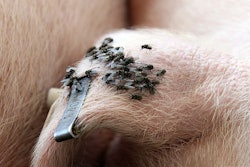
Vitamins and minerals are vital for a broad array of functions in the body and are necessary for healthy, thriving, long-living pets. Each vitamin and mineral plays a unique function in the body, so it is important that the right balance of these micronutrients is included in all complete and balanced pet foods.
Vitamins and minerals as pet food supplements
Most commercial pet foods are supplemented with vitamins and minerals in very small amounts. These supplements act like a “nutrition insurance policy” to provide essential nutrients in the correct ratios required by dogs and cats. It is vital that quality testing is performed to ensure correct inclusion rates in the final product.
Vitamins and minerals are often added to pet food formulations in the form of a premix. Since vitamins and minerals are used in such small quantities, premixes help ensure the correct level of nutrients are evenly distributed in the finished product. With a premix, the micronutrients are mixed twice — once when the premix is made and again when the premix is added to the food. Many factors must be taken into consideration when designing a vitamin or mineral premix, including the nutrient quality, bioavailability, stability and physical characteristics.
Formulation challenges
There is a perception that natural is better when it comes to vitamins. However, from a nutritional perspective, synthetic vitamins are often superior due to their bioavailability and stability. Nutrients need to be in a form that protects the nutrient from breaking down during cooking and food storage, but is released via digestion for usage by the pet. Many nutrients react with the environment, specifically oxygen, moisture and heat. Adequate stabilization protects the nutrient from degradation and is critical to ensuring correct nutrient levels in the food.
The ingredient “blacklist” seems to be getting longer and longer which, as a formulator, is concerning. A current trend that compounds the issue is the move away from vitamin and mineral supplementation. However, this is a risky proposition as nutrient levels in ingredients are inherently variable, which may be intensified with changes in soil quality. When creating a complete and balanced food that is potentially going to feed an animal for its entire life, we need to be absolutely certain that we are doing our best to provide all of the essential nutrients the animal needs.
Let’s look at the Association of American Feed Control Officials (AAFCO) Dog Food Nutrient Profiles for Growth and Reproduction and consider how to meet vitamin and mineral requirements through whole foods alone.
For minerals, calcium, phosphorus and zinc stand out as the greatest potential challenges. Calcium and phosphorus are present in animal protein ingredients, specifically in meat meals that contain significant quantities of ash (i.e., minerals). Achieving the correct ratio of these minerals, which is particularly critical for bone development, may be challenging with ingredients alone. The formulator will likely need to be very choosy when selecting the type and amount of each ingredient to provide the correct total amount and ratio of calcium and phosphorus.
Providing adequate levels of zinc from whole food ingredients is also difficult given that the AAFCO minimum requirement for growth and reproduction in dogs is 100 mg/kg. While oysters are a very rich source of zinc there are few, if any, other ingredients that will be able to contribute enough zinc to meet the AAFCO nutrient profiles for dogs.
When it comes to vitamins, liver is a rich source of vitamin A, and fatty fish and cod liver are sources of vitamin D, but there are not a lot of other options.
Supplementation allows for the development of many different types of pet foods with many different ingredients. Not all pets do well with all types of ingredients. Supplementation allows for more options in ingredient selection because ingredients do not need to be chosen primarily based on the one or two key nutrients that they provide. This allows more flexibility for the formulator and greater ability to customize the nutrient profile of a product, especially when formulating therapeutic diets.
How to safely walk the ‘clean label’ path
With that said, if the desire is to continue to venture down the “clean label” path and develop a food with little or no vitamin/mineral supplementation, what steps should be taken to do to this as safely as possible?
First, you need to know your ingredients and supply chain very well. Ingredients need to be tested and re-tested for each of the essential nutrients they are being relied upon to provide to the formulation and for which a supplement will not be included. The inherent variability in the nutrient must be determined and accounted for in the formulation. The final product must also be tested for levels of all essential nutrients. It’s also important to remember that the assays used to determine vitamin levels have variation in their results. In general, the lower the concentration of the vitamin, the higher the analytical variation. With a full nutrient analysis typically costing several thousand dollars, this is likely going to be an expensive, but necessary, process.
Feeding trials are also something to consider when formulating without supplementation. For diets without vitamins and minerals added, it is much more difficult to ensure that the product meets the nutrient requirements of an AAFCO-recognized nutrient profile. While a trial may not tell you everything you need to know about how a diet will perform, it will provide an extra level of reassurance that a food without supplementation will perform as intended.
While the vitamin and mineral list on a pet food can seem a bit daunting, these are vital components for the well-being of pets. Instead of taking a risk and eliminating them, consumers need to be educated about why supplementation is important.
Dr. Jennifer Adolphe is the senior nutritionist at Petcurean Pet Nutrition.

















